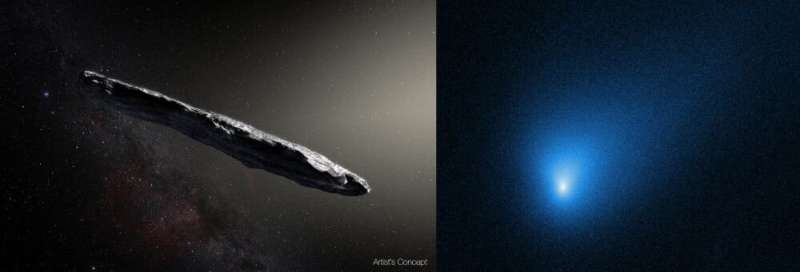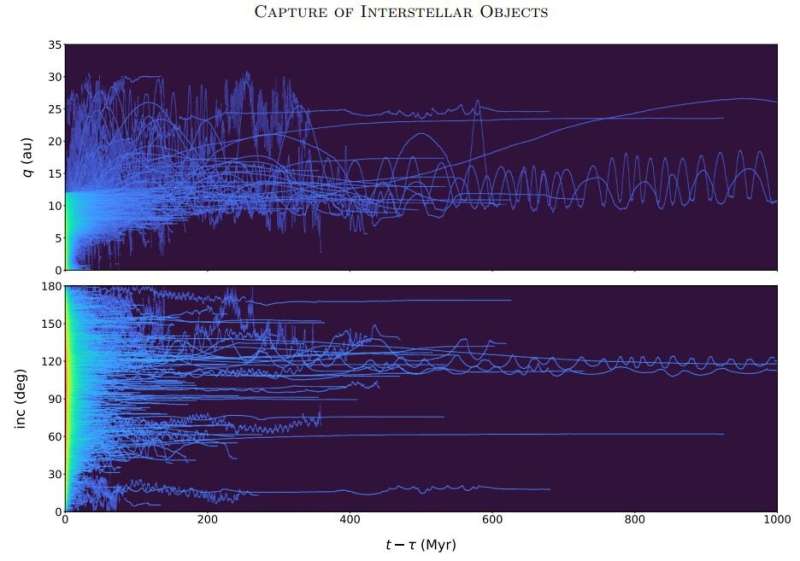What happens to interstellar objects captured by the solar system?

Now that we know that interstellar objects (ISOs) visit our solar system, scientists are keen to understand them better. How could they be captured? If they're captured, what happens to them? How many of them might be in our solar system?
One team of researchers is trying to find answers.
We know of two ISOs for certain: "Oumuamua and comet 2I/Borisov. There must've been others, probably many of them. But we've only recently gained the technology to see them. We'll likely discover many more of them soon, thanks to new facilities like the Vera C. Rubin Observatory.
In a new paper submitted to The Planetary Science Journal, a trio of researchers have dug into the question of ISOs in our Solar System. The title of the paper is "On the Fate of Interstellar Objects Captured by our Solar System." The first author is Kevin Napier from the Dept. of Physics at the University of Michigan.
As things stand now, there's no reliable way to identify individual captured objects. If astronomers could catch an ISO in the process of being captured, that would be great. But the solar system is awfully complex, and that makes identifying ISOs difficult. "Given the complex dynamical architecture of the outer solar system, it is not straightforward to determine whether an object is of interstellar origin," the authors write.

There wasn't much opportunity to study either "Oumuamua or Borisov. They were identified as ISOs by their hyperbolic excess velocity. That means an object has the right trajectory and a high enough velocity to escape a central object's gravity. In this case, the central object is, of course, the sun.
So, could ISOs be captured? Quite likely. "The first step in rigorously investigating this question is to calculate a capture cross-section for interstellar objects as a function of hyperbolic excess velocity…" the authors write.
But that's just the first step, according to the authors. "Although the cross-section provides the first step toward calculating the mass of alien rocks residing in our solar system, we also need to know the lifetime of captured objects." The researchers calculated the lifetime of the objects using simulations, tried to understand what happens to them over time in our solar system, and then came up with a current inventory of captured ISOs.
The researchers identified three overall trends:
- To survive for more than a few million years, captured objects must somehow lift their pericenters beyong Jupiter. (In this case, survival means staying bound to the solar system.)
- Objects on highly-inclined orbits tend to survive for longer than those on planar orbits.
- No object achieved permanent trans-Neptunian status (ie q=30 AU.)

In the first case, if an ISO can't lift its pericenter beyond Jupiter, it'll probably be pulled into the gas giant and destroyed. In the second case, objects on highly inclined orbits are less likely to encounter a planet because most of the time they're out of the solar system's plane. Objects on planar orbits are more likely to encounter a planet and be perturbed and sent back out into interstellar space. In the third case, it's difficult for an ISO to achieve permanent trans-Neptunian status because it would take a very unlikely chain of events.
The simulations have some limitations, which the authors explain. They've only accounted for the solar system's four largest planets and the sun. The smaller bodies are either not massive to have much effect, or what effect they would have is dwarfed by the sun. They also ignore out-gassing, radiation pressure from the sun, or drag from planetary atmospheres, which would be extremely rare anyway, and not likely to affect the results. "Each of these approximations is rather modest, so that including them would make relatively little difference to our conclusions," they explain.
Overall, the simulation shows that over time most captured bodies would be ejected from the solar system. It takes a while, though. That's because most ISOs would simply pass through the system, and the ones that were captured into an unstable orbit of some type would go through many orbits, 30 in this work, before being ejected. That's because captured objects typically have semi-major axes of 1000 AU with orbital periods of about 30,000 years. So it takes at least one million years before any captured ISOs could be ejected.
The researchers also calculated the populations of captured ISOs that might be in our solar system currently. They point out that there are two distinct time periods when objects can be captured that are of interest. The first is in the early days of the solar system when the sun is still in its birth cluster of stars, and objects from within that cluster could be captured. The second is when the sun resides in the field.
In their simulations, the trio of scientists used 276,691 synthetic captured interstellar objects. Of those, only 13 survived for 500 million years, and only three objects survived for one billion years. But these results come with detailed caveats that are best explained in the paper itself.
The authors point out that their simulations might be useful in understanding panspermia. If the chemicals necessary for life, or even life itself, can somehow travel between solar systems, the ISOs likely play a role. Maybe the most prominent role.
They also mention the Planet Nine scenario. One of the authors of this paper, Konstantin Batygin, along with Michael E. Brown, hypothesized a so-called Planet Nine. The Planet Nine hypothesis states that another planet about five to 10 times the mass of Earth is in a wide orbit with a semi-major axis of 400 to 800 AUs. Planet Nine, if it exists, would take between 10,000 and 20,000 years to complete one orbit around the sun.
According to this paper, when included in the simulations, Planet Nine "…yielded rich dynamics that did not appear in the simulations including only the four known giant planets."
More information: Kevin J Napier, Fred C Adams, Konstantin Batygin, On the Fate of Interstellar Objects Captured by our Solar System. arXiv:2109.11017v1 [astro-ph.EP], arxiv.org/abs/2109.11017
Journal information: The Planetary Science Journal
Source Universe Today



















